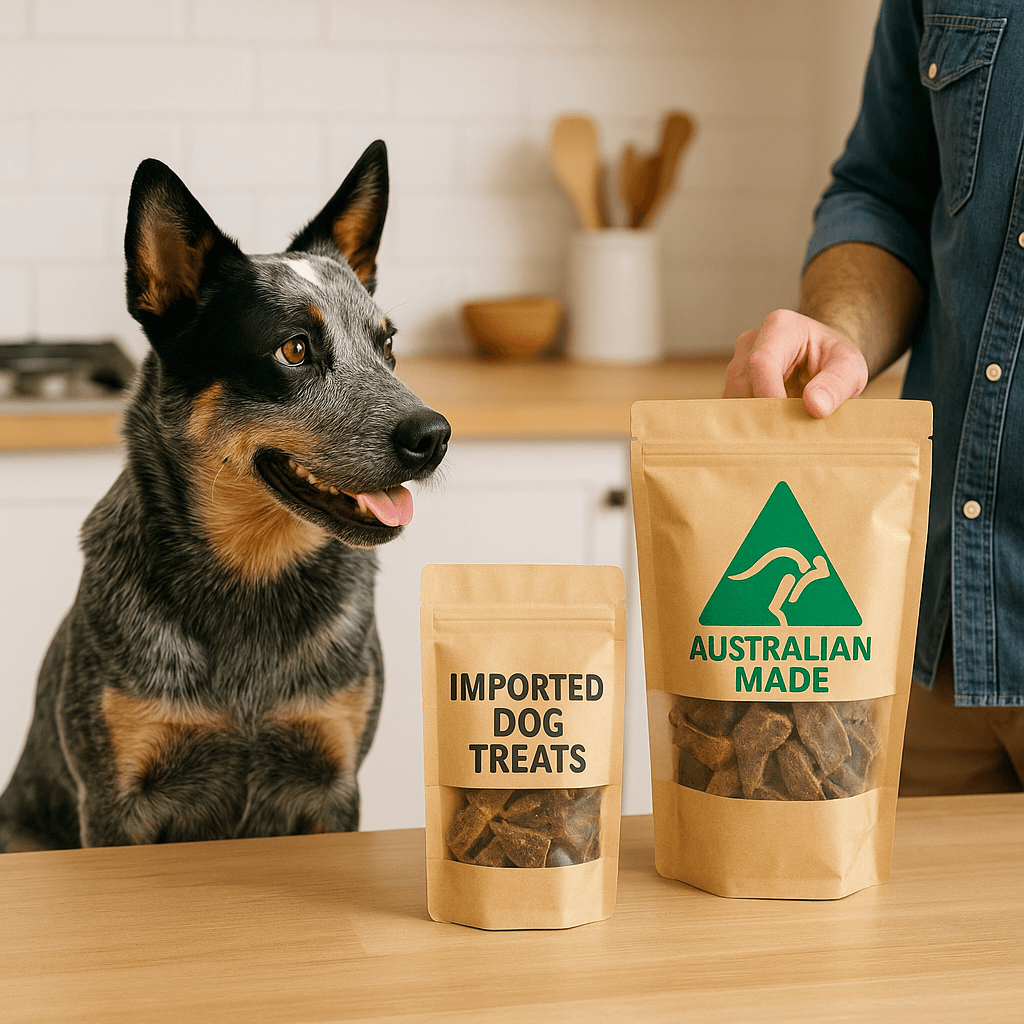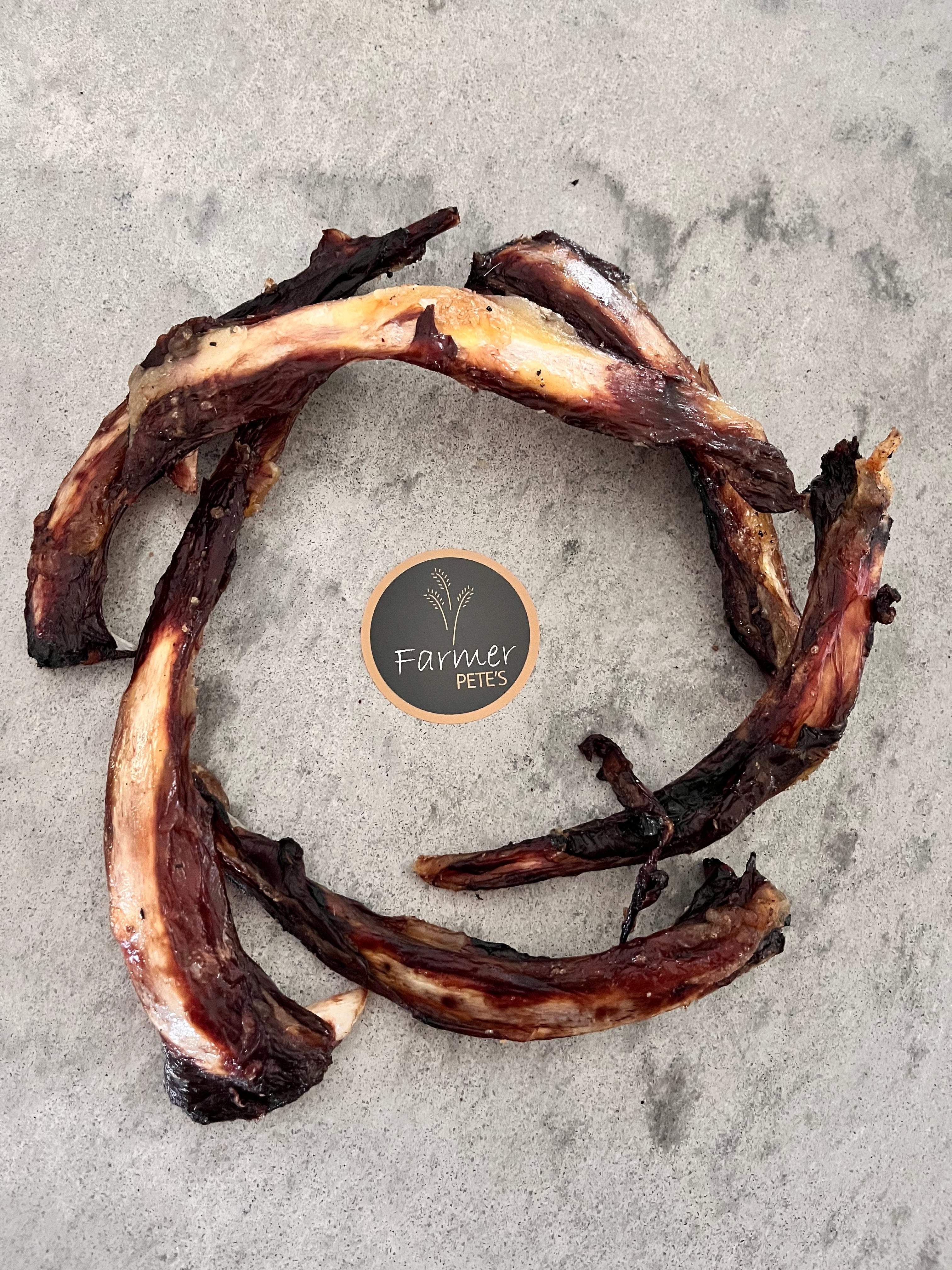You might not think of mould as a good sign, but if your dog’s treats eventually grow mold, then it means you’re feeding your pup natural, preservative-free treats that will help them enjoy a happy and active life.
Finding a loaf of mouldy bread in your cupboard might be an inconvenience that means an unscheduled trip to the shop, but most people are used to the idea that food naturally spoils. But as a pet parent, have you ever wondered why your dog’s food or treats never seem to go bad?
While it may be convenient that you don’t have to worry about mouldy pet treats, there is an upside to buying your dog food that spoils: it means your pup is eating fresh, wholesome food made with real ingredients. Artificial preservatives may extend the life of your dog treats, but you’ll do your pup a favour by switching to preservative-free 100% natural treats such as Farmer Pete’s.
Common Preservatives in Dog Food Treats
Lots of dog foods and treats contain preservatives that prevent the fats in the food from going rancid. Spoiled food can make your dog sick, and that’s why pet food and treats have artificial or natural preservatives.
It can be difficult to decipher what’s what on a pet food label, but some of the common artificial preservatives you’ll find in dog treats are butylated hydroxyanisole (BHA), ethoxyquin, and butylated hydroxytoluene (BHT).
Many pet parents try to avoid artificial preservatives for their dogs because there’s evidence that some of them can negatively impact a dog’s gut health, protein digestion and Metabolism.
There are plenty of natural alternatives for preservation, such as honey, salt, sugar and ascorbic acid, corn flour, wheat flour, flavours, colours, humectant, just to name a few. However, this is not necessarily a safe alternative as to much of a natural preservative is not a good thing either.
Common Types of Mold on Dog Treats and Chews

Mold is a fungus that lives on plant or animal matter, and there are currently over 300,000 different organisms.
Aspergillus
This type of mold is widely referred to as "black mold." There are hundreds of different species of this mold, but the most common ones affect damp walls and decomposing organic materials (including dry pet food).
Penicillium
This mold type can be used on cured meats and a variety of cheeses. This is usually a white-coloured spot found on salami or air-dried and dehydrated meat and chews. In certain cases, they may be helpful by preventing the colonisation of harmful fungi or bacteria.
Penicillium citrinum is the most common mycotoxin producer, and it's found in wheat, rice, corn, barley, oats, and rye. For those that are allergic to mold, spores from this form of mold may cause allergic reactions. They contain spores that are bluish, greenish, and yellowish in colour.
Cladosporium
This type of mold is known for growing on cereal grains (which includes dry pet foods), vegetables, and refrigerated meat, among other items. It usually takes a long time to develop and appears as black spots on foods, causing spoilage and discoloration.
Alternaria
This mold is a plant pathogen, which means it can damage a variety of agricultural products including grains, fruits, and vegetables. It can be found on dead plants, cereal grains, and grasses outdoors.
Toxic Molds
Some molds can produce toxins that are harmful to humans and animals. These toxins are known as "mycotoxins." Mycotoxins are substances formed by certain molds and fungi that can be contained in food.
They’re most commonly found in pet food (kibble) that are made with corn, wheat, rice, bran and soy. These foods are usually considered cheap fillers, so there is little reason to put them in dog food to begin with, but their increased risk on mold toxicity makes them even worse ingredients.
The key concern with mycotoxins is that they can cause serious illness in both the short and long term from contaminated food.
Aflatoxins
Aspergillus molds produce aflatoxins, which are among the most toxic mycotoxins. They thrive in dirt, rotting vegetation, hay, and grains, and they can contaminate cereals (corn, wheat, rice), spices, and tree nuts.
Corn, wheat, and rice are still popular sources of protein in many dry pet food brands today, and they pose a higher risk of aflatoxin contamination than foods containing more meat protein.
Since aflatoxins are commonly present in cereal grains, pet foods containing corn gluten meal, whole grain corn, corn starch, sorghum, rice, wheat, and maize should be avoided. They are not only a source of unwanted carbohydrates, but they can also contain mold that's toxic to your dog.
Is All Mold Dangerous For Dogs?
NO! As mentioned above, there are hundreds of thousands of types of molds and most won’t affect your dog at all. Dog treats that eventually go moldy are a sign that the treats are natural and preservative-free for healthy, and happy pups.
What Causes Mold In Dog Food?
Temperature swings from hot to cold can cause moisture to develop in a food bag or plastic tub. Moisture, especially in combination with heat, can trigger the growth of molds, and toxins may develop in the food.
When you use fresh and natural ingredients, the shelf life of your treats will shorten significantly. The benefit of full nutrition without additives comes at the price of a shorter usable life. I don’t think you pup will mind!
Heat, ventilation, dehydration time, ingredients, and storage are the most important factors that affect how long your dehydrated treats will last.
How To Prevent Mold Building On Your Dogs Food Treats
Properly storing your food will reduce the risk of mold in your treats and chews. Even though not all mold is toxic, it's best to stop mold growth as much as possible. Continue reading and find some helpful hints for keeping your treats fresh before and after opening
Before you open the bag
Preservatives are never used in Farmer Pete’s natural, dehydrated treats. This is fabulous because it means you're feeding your pet real food. It does, however, suggest that you pay attention to "best before" dates. For example, each treat and chew from Farmer Pete’s includes care and storage tips, so put them in the freezer if you know your dog won't finish them in a month or two.
Depending on where you live, the weather and temperature might be a big factor in storing your treats. For those that encounter extreme weather, adjust your practices to take in account especially hot days that might shorten your treats’ life span.
After opening the bag
Chews
Many people choose to give their dogs larger chews over several chewing sessions. Although this is perfectly acceptable, make sure the chew is completely dry before returning it to the freezer or refrigerator. Mold prefers moisture and can flourish in the fridge if it was wet when it entered, so reducing the amount of moisture on the chew is the first line of defence against mold.
If your dog has had at least one chew session, cover the chew in baking paper or grease-proof paper then freezing or refrigerate it. Dogs also love frozen chews, and it takes even longer to get through.
Treats
Since the bulk of the moisture has been removed and there are no grains, dehydrated treats and chews that are 100 percent meat are less vulnerable to mold. However, they, can still harbor mold when exposed to moisture from the environment or from your dog's mouth.
Don't worry; dehydrated meat is similar to hard cheese in that it isn't porous, so removing the moldy portion can help you save the rest of the treat. When it comes to mold prevention, store dehydrated treats and chews in a cool, dry place (or in the freezer or fridge).
For treats that are thin and hold no water content such as Jerky, heart, and Liver store them in an airtight container after opening the bag.
How Long Do Dehydrated Dog Treats Last?
Dehydrated dog treats will last for 3- 5 months at room temperature when properly stored in an airtight container. You can extend their shelf life by freezing them for an additional 3 months.

Why Discerning Pet Parents Choose Farmer Pete’s Treats
Farmer Pete’s uses 100% natural Australian ingredients in their dog treats. They contain no artificial preservatives, sweeteners, by-products, GMOs, or fillers, so they actually do go mouldy if they sit open in the cupboard for too long, or in hot, humid conditions. I don’t think you dog will let that happen!
Pups of all sizes and ages find the treats irresistible, and they can even help distract dogs with separation anxiety.
Give your love to your dogs in the shape of Farmer Pete’s delicious, dehydrated treats that will last for weeks. They will not only love you more, but you will be making sure that they get all the nutrients and none of the bad stuff. Being a good dog parent takes time and patience, but it is one of the best experiences of your life.
Visit Farmer Pete’s today and get your paws on some all-natural, preservative-free treats that your dog will go nuts for! Treat your pup to treats every month. Whether your dog has a taste for treats or chews, consider getting them a Farmer Pete’s subscription! That way you will always have a steady flow of fresh nutritious preservative-free 100% natural treats and chews for your pup. These treats won’t be on your shelf for long!



